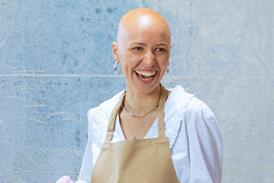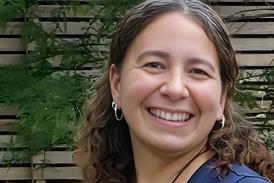
I was inspired by Lindisfarne
Amy Sparkes has some lasting souvenirs from her day trip to Holy Island
I love the name ‘Holy Island’. It was given in 1082 by monks who rebuilt the priory on the island after it was destroyed by raiding Vikings in 793AD. Perhaps they named it Holy Island in defiance of the evil and destruction they witnessed in the world around them. Certainly the name gives the impression of a very special place – a place of truth and sanctuary from the madness of life; a reminder of the way life should be lived and what life itself is really all about.
Being an island, Lindisfarne is physically separated from the mainland, and this struck me as also symbolising a spiritual separation from the world – holiness versus worldliness.
As I discovered more about monastic life at the Priory Museum, I was struck by the stark contrast to the way I lived my own hectic life. Their lifestyle was totally God-centred, and I found myself craving the simplicity and focus that these monks had.
Although the monks in those days certainly had their own problems, they wouldn’t have been spending their time fussing about where to spend their holidays next year, or which new hobby to pursue, or whether the haircut they had really suited them.
Of course, none of these things are wrong in themselves, and we are blessed to have so many choices and opportunities. However, I couldn’t help feeling that I spent far too much precious energy chasing around after things which, in the grand scheme of things, really didn’t matter.
Embracing an eternal perspective, the monks simply had no room for any unnecessary busyness or distracting clutter – be that spiritual, emotional, mental or physical. They just lived their lives to the best of their ability, loving the Lord and the people he created.
After learning about the monks’ attitude to life, I felt a desperate need to ‘get back to basics’ and focus again on the one thing which truly mattered: God. If I could get that right, I knew the rest would fall into place.
And yet it was all too easy to submerge myself in the busy distractions of the world. I’m very glad we have a forgiving and gracious God, who patiently teaches us. It gives me hope that one day I might truly be able to cast off what is hindering (and distracting) me and press on towards the goal. In the meantime, I still struggle with three steps forward, two steps back.
As well as discussing the monastic lifestyle generally, Lindisfarne Priory museum also features an outstanding monk: Saint Aidan. It was this saint who founded the original monastery on the island in 635. I discovered his statue in the grounds of the Priory, standing with a Celtic cross behind his head, his face lifted to heaven and his hands holding a torch symbolising the light of the Gospel. It seemed fitting that his presence was still on the island, many centuries later, reminding residents, pilgrims and visitors of his mission.
What I discovered about St Aidan was hugely inspiring and a true example of effective evangelism. He was a missionary summoned from Iona by King Oswald, a Christian convert. Interestingly, he was actually second choice. The first missionary, Corman, gave up on the Northumbrians, calling them an “uncivilised people of obstinate and barbarous temperament.” It is surely a testimony to Aidan’s dedication and evangelistic heart that instead of giving up, he stayed and persevered.
As a result of this devotion, his presence on the island changed the people of Northumbria. The Venerable Bede recorded that “many Northumbrians, both noble and simple, laid aside their weapons, preferring to take monastic vows rather than study the art of war.” What an impact! This is what happens when we obey God, and enthusiastically carry out what he asks us to do.
Considering my own evangelistic efforts, I felt quite challenged. I could certainly think of several people I knew of obstinate, if not barbarous, temperament and I struggled even to pray regularly for some of them!
In the first few years following my conversion, I was an enthusiastic evangelist, and several of my friends became Christians. However, over time, without realising, this passion had cooled and I found praying persistently for others very difficult, especially when prayers for salvation seemed unanswered.
In many ways, my attitude had become almost defeatist - definitely more ‘Corman-like’ than ‘Aidan-like’. Understanding how God used Aidan as a vessel to change the hardened Northumbrians filled me with a desire to completely yield to God and sparked a renewed passion for evangelism.
I was also very moved by a story which showed how Aidan witnessed with both words and actions. He developed a good relationship with Oswald’s successor, King Oswin, who presented Aidan with a horse to help him on his long journeys as he preached the Gospel. But, shortly afterwards, Aidan met a poor man begging for alms and, in response, he gave the man his horse and continued to make his journeys on foot.
I suddenly realised how the materialism which cripples the world had slowly been gripping me, and I wondered how willing I would be to part with something I considered very valuable – financially or personally – to follow God’s leading.
My messy house is bursting at the seams with stuff which isn’t particularly useful at all, and yet Aidan was prepared to part with his newly-acquired horse – a very precious commodity in those days. Did I really ‘bless the poor’ as much as I could and affirm my faith with actions?
This motivated me to re-examine my priorities, and have a good think about what positive actions I could take. Adapting your lifestyle is a long-term project really, but we have made a start and our family has adopted a child in a developing country, which has proved to be a real blessing.
Following Aidan’s example, we are now not only redirecting our material wealth, but also building relationships and telling people about the love of Jesus. (Except instead of doing it by walking for miles, we thankfully have the benefit of a postal service!)
Visiting Lindisfarne was certainly an interesting trip. I thought that it would be lovely to call our baby Aidan after the dedicated saint who made his home on this island. And when, inevitably, someone should say, “Aidan - that’s a lovely name”, I will try to explain why this name was chosen and tell them of the man whose devotion to God transformed a country. Who knows – maybe it will be an opportunity to share the Gospel? I’m sure St Aidan would be pleased.






























